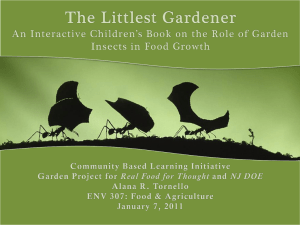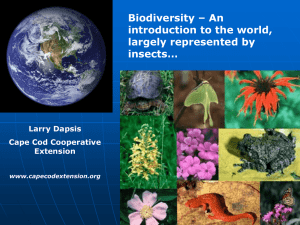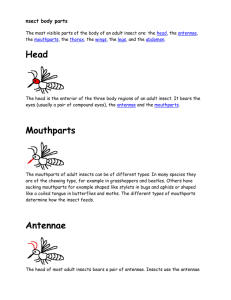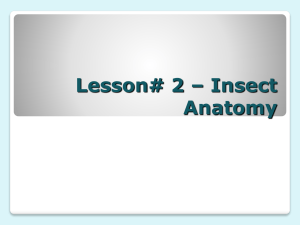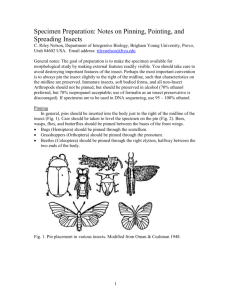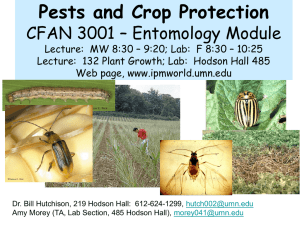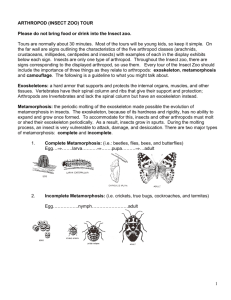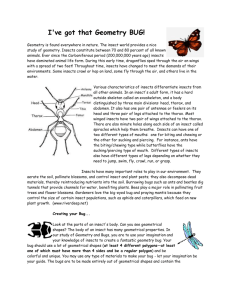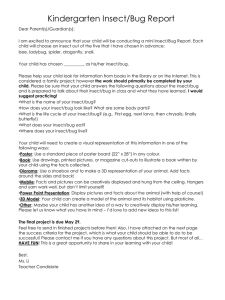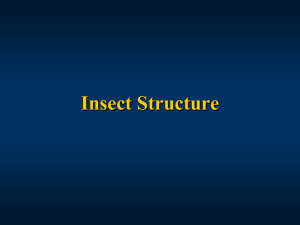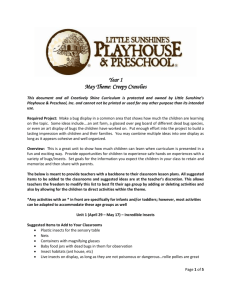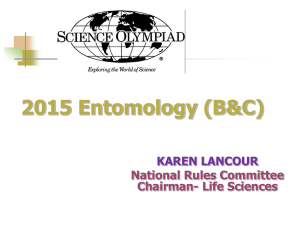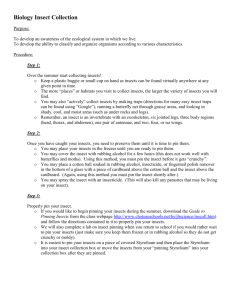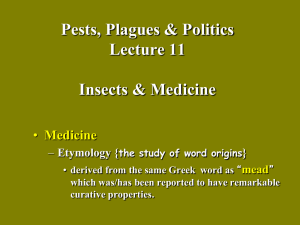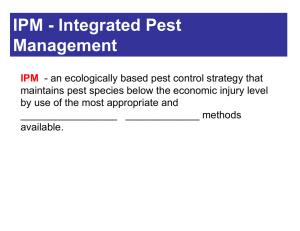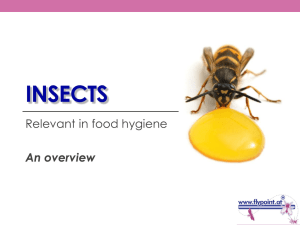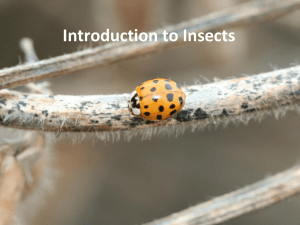Bugs for Birds! Insects, their characteristics, other
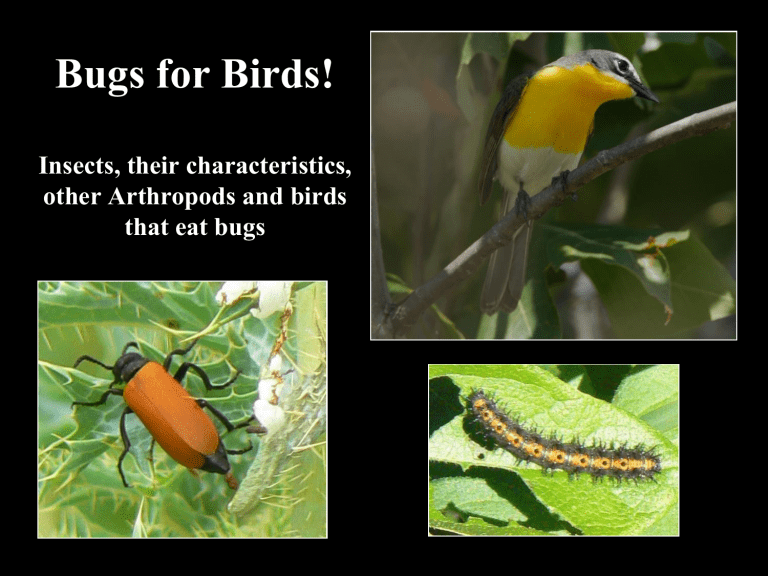
Bugs for Birds!
Insects, their characteristics, other Arthropods and birds that eat bugs
What is an Insect?
Characteristics:
• 3 pairs of jointed appendages (6 legs)
•
3 body parts: head, thorax, abdomen
• Tough exoskeleton
• Most have wings
•
Mouthparts
•
Compound and simple eyes
•
Antennae
Which is an insect?
Both of these belong to a very large group of animals called Arthropods
Arthropods
• jointed appendages (legs)
• segmented body
• tough exoskeleton
A Spider is an arthropod but not an insect because it has 8 legs, two body parts and fang-like mouth parts to poison prey
This Green Lynx spider is eating a fly it caught from ambush
Spiders are Arachnids not Insects
Arachnids have 8 legs, biting mouth parts, and no antennae
Scorpions, tarantulas, and Harvestmen also are Arachnids
Scorpions have many segments Tarantulas have two segments
Harvestmen have one segment
Other Arthropods
Crustaceans
(crayfish & shrimp)
Yellow-crowned Night-Herons and other types of birds eat crustaceans
Photo by Eric Runfeldt
Other Arthropods
Centipedes and Millipedes
Millipedes & Centipedes have many body segments
Centipedes have 1 pair of legs to each body segment
Millipedes have 2 pairs of legs to each body segment
Percent Insect Species on Earth
All Other Animal
Species
27%
Insect Species
73%
Insect Species All Other Animal Species
Percent Insect Species and All Other Plant & Animal Species
All Animal & Plant
Species
43%
Insect Species
57%
All Animal & Plant Species Insect Species
Major Insect Groups and the Birds That Eat Them
ORDER ODONATA
Damselflies
Hold their wings together when resting
Dragonflies
Hold their wings out flat when resting
ORDER ORTHOPTERA
Grasshoppers
Have short antennae and ovipositor
Katydids
Have long antennae and ovipositor
Bobwhite feed grasshoppers to their young
ORDER COLEOPTERA
Beetles
Largest group of insects
Have wings that meet in a straight line down middle of back
Black-throated Green Warblers like to eat beetles, caterpillars and other insects
ORDER HEMIPTERA
True Bugs
Have wings that look like a shield
Cardinals feed insects to their young. From top left to right: milkweed bug, red & black plant bug, broad-headed bug, green stink bug, squash bug and water striders
ORDER LEPIDOPTERA
Moths & Butterflies
Covered with powdery scales
Moths fly mostly at night and butterflies during the day
Yellow-breasted Chats eat moths
Allianthus Webworm moth flies in day (above left), Witch moths fly at night (above right) as do
Polyphemus moths which have spots like eyes to scare away predators
Beautiful Butterflies
Sulfur Butterfly
Common Buckeye Butterfly Gulf Fritillary Butterfly
Hackberry Emperor Eastern Tiger Swallowtail
ORDER HYMENOPTERA
Wasps, Ants, & Bees
Have stingers on tips of abdomen and 2 pairs of wings
Left to right: Yellow Jacket, Bumblebee, Blue-winged Wasp, Carpenter Bee, Ichnuemon
Wasp, Honeybee, Spider Wasp eating a spider, and Scolid Wasp. Audubon’s Warbler is one bird that eats wasps!
ORDER DIPTERA
Flies
Have 1 pair of wings
Left to right: Yellow-backed Robber Flies;
Mosquito, Flower Fly, Bee Fly, Green Bottle Fly.
Magnolia warblers eat flies and many other kinds of insects
What does a Golden-cheeked Warbler Eat?
Almost entirely insects!
Can you name the bugs below?
(hint match these names to the bugs pictured below- flies, moths, ants, damselfly, caterpillars, walking stick, shield bug, beetles)
Can you find and name the hidden insects in these pictures?
They are using camouflage to keep from getting eaten!
Birds love to eat fat, juicy nutritious bugs!
Funding to develop these instructional resources was provided by Texas Parks and Wildlife Department contract
#409330 and U. S. Fish and Wildlife
Service Section 6 grant TX E-133-R
Photos by Pat, Chris, and Nicole Merkord, Eric Runfeldt, and Gil Eckrich
Alignment
Alignment is provided to the Texas Essential Knowledge and Skills (TEKS) for English Language
Arts and Reading, Mathematics, Science and Social Studies where applicable and color-coded for each grade level.
Grade 3 (red)
Grade 4 (blue)
Grade 5 (green)
Grade 6 (purple)
English Language Arts & Reading student expectations: 3, 4(A,B) ; 1, 2(A,B) ; 1, 2(A,B) ; 1, 2(A,B)
Mathematics student expectations: 11(A)
Science student expectations: 3(A), 10(A) ; 3(A), 7(C), 9(A) ; 3(A), 9(A,B), 10(A) ; 3(A), 12(E,F)
Social studies student expectations: 17(E) ; 21(A-C), 22(A) ; 24(A-C), 25(A) ; 3(A), 21(A-C), 22(A)
Funding to develop these instructional resources was provided by Texas Parks and Wildlife Department contract #409330 and U. S. Fish and Wildlife Service
Section 6 grant TX E-133-R

